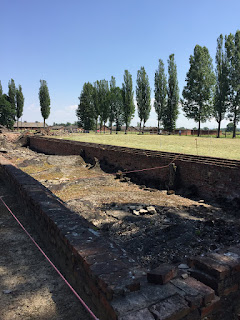Tracks in Auschwitz II Birkenau
The bus drove us the 90 minutes to the site and while in transit, we watched a film that used archival footage of liberation in 1945 by the Red Army and and interview with a Red Army photographer who was present at liberation. And then we were there. Auschwitz I and Auschwitz II-Birkenau are several kilometers apart and we began with Auschwitz I. It has the most preserved buildings a number of which are used as museums. Walking around in 95 degree heat with many, many other visitors, was an effort and contributed to the experience of actually seeing the relics (executions walls, starvation cells, "hospital" where gruesome medical experiments were performed and torture cells) of this history which we have heard so much about. No matter what you think you know, it is shocking and revolting to see where it happened - at least in this one place. Our bus brought us from Auschwitz I to Birkenau and we toured there. There is not much left in the way of buildings, a few barracks stand reconstructed as an example. We saw remnants of the crematoriums which the Germans blew up when they knew the Red Army was about to arrive, a railway car, a guard tower, the pit of human ashes. At the end of the iconic railroad tracks past the dividing platform where those who were transported here were told to go to the gas chamber or to live a short time longer to benefit the Nazi cause there is a memorial for the victims. This was the death camp. 2/3 of those who came here died in the gas chambers immediately. Most of the others went into forced labor fed 900 calories a day. It didn't take long to die. Auschwitz I was mostly for the Poles and political prisoners. Auschwitz II or Birkenau was to kill the Jews. more efficiently than could ever be done at Auschwitz I.
Execution Wall Auschwitz I
Foundation of Crematorium Auschwitz II
Part of the Memorial
Barracks
Ashes of the victims
All of this is surrounded by idyllic Polish countryside now dotted with villages and farms. It was a quiet ride back to Krakow. It is not the easiest place to visit but neither of us could come to this part of Europe without making the pilgrimage to honor all the victims of this genocide. I know people say we need to visit and see to remember so that this will not happen again but it seems that humans have a long and documented history where genocide happens again and again. Cambodia, Rwanda, Tutsi and Hutu, Shia and Sunni, indigenous populations on several continents including our own, Armenia, and more. I could go on; there are many, many more. It's hard to find the words. Sad? Angry? They hardly seem adequate.






No comments:
Post a Comment